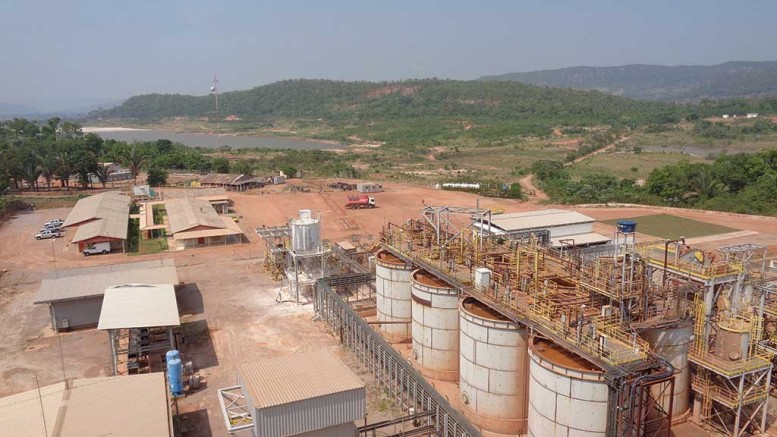Aura Minerals (TSX: ORA) has tabled a positive feasibility study on its recently acquired Ernesto/Pau-a-Pique (EPP) gold project in Brazil’s western Mato Grosso state, not too far from its producing Sao Francisco gold mine.
The study envisions production at EPP — comprising three deposits — to average 41,000 oz. gold a year over 5.5 years. Production will first start from the Lavrinha pit, followed by restarting the Pau-a-Pique underground mine and then developing and producing the Ernesto underground deposit.
Ernesto and Lavrinha are both 60 km south of the Sao Francisco mine — where operations resumed in April 2011 — and 12 km from the town of Pontes e Lacerda. The two deposits are near a functional processing plant, which is 5 km from Pau-a-Pique. That deposit is 47 km south of Ernesto and Lavrinha.
Fernando Cornejo, the company’s vice-president of projects, describes EPP as an “outstanding opportunity” for Aura. “It is an excellent fit with our Sao Francisco mine, in terms of timing, size and location. This new project will ramp up as Sao Francisco ramps down,” he writes in an email.
Aura bought the EPP project in June from Serra da Borda Mineracao e Metalurgia S.A. (SBMM) — a company affiliated with Yamana Gold (TSX: YRI; NYSE: AUY) — through shares, warrants and a net smelter return royalty. To facilitate the acquisition, Yamana provided a working capital facility of up US$9 million to get the project going.
The study, prepared by a large group of consultants — including P&E Mining Consultants, MCB Brazil and Knight Piesold Canada — pegs EPP’s start-up costs at US$17.3 million.
It assumes the Yamana debt facility will fund part of the project, along with Aura’s recently closed US$4-million rights offering. Management aims to cover the rest of the costs internally, Cornejo reveals.
The initial capital is relatively low, as EPP benefits from existing infrastructure — including roadways and the 3,000-tonne-per-day processing plant, both put in place by the previous project owner — with Cornejo noting there are several synergies with the Sao Francisco mine, which further de-risks the project.
The plant, commissioned in 2012, treated ore from the Pau-a-Pique underground mine and the Ernesto pit through a conventional carbon-in-leach process until closing in December 2014.
Aura intends to transfer Pau-a-Pique’s existing mine fleet to the Ernesto underground deposit once it completes production at Pau-a-Pique. Revenue generated from the Lavrinha pit will help develop the two underground deposits.
“The idea is for this project to be self-financed. So the open pit will be the first project and revenues from that project will allow us to subsidize the next developments, meaning the second underground restart and the development of the third underground,” Cornejo says in an interview.
Aura, he points out, has already started pre-stripping and pre-production at Lavrinha, and expects to reach commercial production there within “three to six months.”
The company anticipates first production from Pau-a-Pique in early 2017, followed by underground development at Ernesto by mid-2018.
According to the feasibility study, Aura will use a full-service contractor to extract 1.1 million tonnes of ore averaging 1.69 grams gold per tonne and 14 million tonnes of waste from the Lavrinha pit over 2.5 years. The overall waste-to-ore strip ratio is 12.6-to-1. Material movement rates would range from 15,000 to 25,000 tonnes per day.
At Pau-a-Pique, the study envisions using an Avoca choke-blasting stoping method, before trucking the ore to the run-of-mine pad on surface. The underground mine should deliver 320,000 tonnes at 3.24 grams gold over 17 months, at a rate of 850 tonnes per day.
Aura intends to use a drift and fill mining method at Ernesto. After six months of preproduction, Ernesto is set to deliver 3.5 years of production, or 870,000 tonnes of ore at 5.03 grams gold. Production should average 800 tonnes per day.
Over the life-of-mine, EPP could churn out 217,600 oz. gold from 2.3 million tonnes of ore at 3.17 grams gold, at a 93% plant recovery.
The study estimates US$1,086 per oz. all-in sustaining costs and US$283 million in gold revenue.
Economics for the EPP project are favourable at both current and higher gold prices.
Applying a gold price of US$1,300 per oz. and a 5% discount rate, EPP generates a US$39.5-million after-tax net present value (NPV) and 77% internal rate of return (IRR). Using the current US$1,200 per oz. gold price, the after-tax NPV and IRR come in at US$21.7 million and 39%.
To grow the project, Aura aims to explore and develop the nearby Nosde, Japones and Pombihnas targets, all near the processing plant. While the plant would use 70% of its capacity in 2017, Cornejo says developing these targets should keep the plant full and extend the mine life.
Aura shares closed Nov. 22 flat at 18¢, unchanged by the feasibility study.
The company recently reported a third-quarter income of US$734,000, or 1¢ per share, below the 2¢ per share earned in the year-ago period. Over the same time, its cash and equivalents fell to US$2.9 million from US$3.7 million.
Along with the Sao Francisco mine, Aura operates the San Andres gold mine in western Honduras, which has received criticism over the years. In a move to strengthen its community ties, Aura signed a social licence agreement with the Honduran community of Azacualpa in August.
Cornejo says EPP has “tremendous upside potential,” and combined with San Andres could position the company for growth.


Be the first to comment on "Aura Minerals sketches positive economics at EPP"